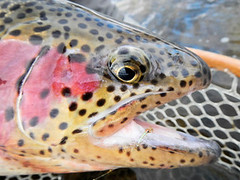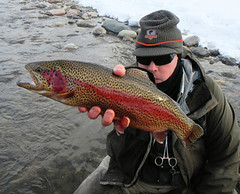THE BLUE-WINGED OLIVE (BWO) is not a single species, but a group of them in the genus Baetis. There are many mayflies out there with olive bodies and gray or dun-colored wings, the key during a BWO hatch is to get the size right. These tiny mayflies rule the rivers half the year, the half most people don’t fish. Hatches can begin as early as late September and continue until April, with the best activity in February and early March. I’ve never been out fishing in the winter when we didn’t have a few blue-winged olives every afternoon.
The Baetis nymphs are active swimmers and live in almost all types of running water, but slow to moderate runs hold the largest populations. Beatis nymphs have a habit of purposefully drifting short distances (behavioral drift) in the current when they feel overcrowded to find a new home; sunrise and sunset are the prime times for this activity. Thus nymph imitations can be productive even when there is no hatch in progress. Morning and evening are great times to rig up double Baetis patterns on a nymph rig and make sure to let it swing at the end of the drift. This will trigger a lot of strikes that sometime can be pretty violent.
During a Beatis hatch, it’s important to collect an insect and look at its underside before you choose a fly pattern to match it. The belly will always be a different color–usually lighter and more olive–than the back. It’s the belly, not the back, that trout see when they take a floating insect. Again, it is important during this hatch to get the size of your imitation right. If you just glance at a small insect like this, and choose a pattern based on that glance, your pattern will almost always be a size, or even two sizes, too large. Set your collected natural right next to the imitation you’ve chosen for it, and be sure that they are the same size.
There is really not a single pattern that will cover a Baetis hatch. I now realize it’s important to carry an emerger pattern, two or three dun patterns, and a spinner pattern–all tied in a narrow range of sizes. Trout might take one for a while, and suddenly turn off until you try another.




In my experience, it is also a good idea to carry a diving female imitation (adult)…
PT/TB
I have read alot of articles over the last few years, I have never realized any of this information. You need to write a book, very simplified just like this article. I will buy the book. Great knowledge, and thank you
Mark Thienes